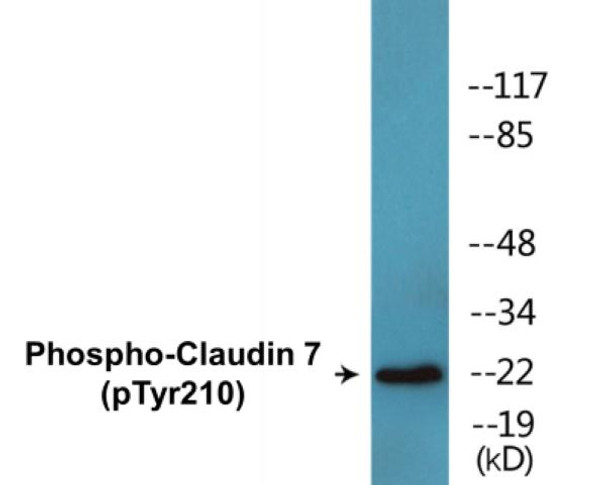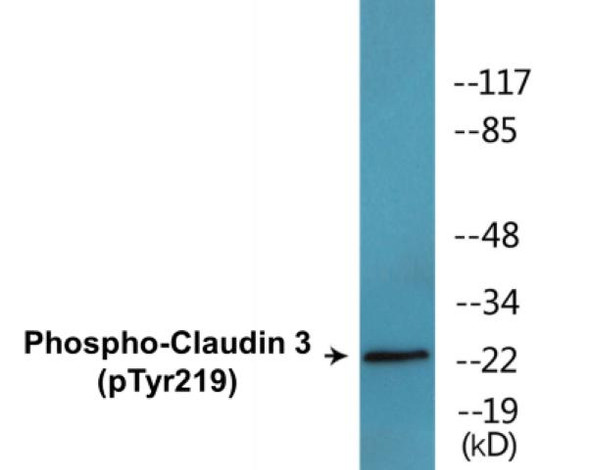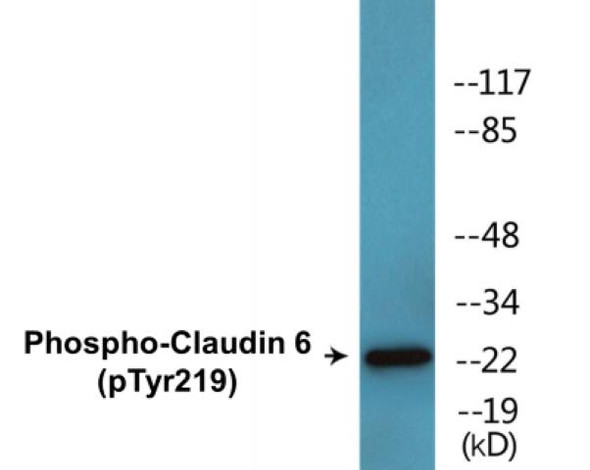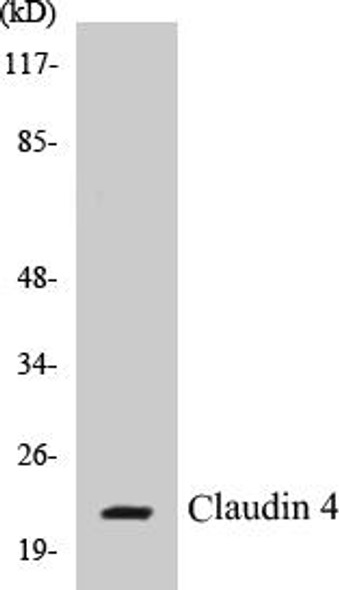Claudin 7 (Phospho-Tyr210)Colorimetric Cell-Based ELISA Kit (CBCAB01676)
- SKU:
- CBCAB01676
- Product Type:
- ELISA Kit
- ELISA Type:
- Cell Based Phospho Specific
- Reactivity:
- Human
- Mouse
- Rat
- Detection Method:
- Colorimetric
Description
Claudin 7 (Phospho-Tyr210)Colorimetric Cell-Based ELISA Kit
The Claudin-7 Phospho-Tyr210 Colorimetric Cell-Based ELISA Kit from Assay Genie is a powerful tool for researchers studying cell signaling pathways and protein phosphorylation events. This kit allows for the precise measurement of phospho-tyrosine 210 levels in cells, providing valuable insights into the activation status of Claudin-7.Claudin-7 is a key protein involved in cell-cell adhesion and barrier function in epithelial tissues. Phosphorylation of Tyr210 on Claudin-7 has been linked to changes in cell morphology, migration, and proliferation, making it a crucial signaling event in various cellular processes.
With its high sensitivity and specificity, the Claudin-7 Phospho-Tyr210 Colorimetric Cell-Based ELISA Kit offers reliable and reproducible results, making it an essential tool for investigating the role of Claudin-7 phosphorylation in health and disease. Whether studying cancer progression, inflammation, or developmental biology, this kit provides a comprehensive solution for researchers looking to unravel the complexities of cell signaling pathways.
| Product Name: | Claudin 7 (Phospho-Tyr210)Colorimetric Cell-Based ELISA Kit |
| Product Code: | CBCAB01676 |
| ELISA Type: | Cell-Based |
| Target: | Claudin 7 (Phospho-Tyr210) |
| Reactivity: | Human, Mouse, Rat |
| Dynamic Range: | > 5000 Cells |
| Detection Method: | Colorimetric 450 nm |
| Format: | 2 x 96-Well Microplates |
The Claudin 7 (Phospho-Tyr210) Colorimetric Cell-Based ELISA Kit is a convenient, lysate-free, high throughput and sensitive assay kit that can detect Claudin 7 protein phosphorylation and expression profile in cells. The kit can be used for measuring the relative amounts of phosphorylated Claudin 7 in cultured cells as well as screening for the effects that various treatments, inhibitors (ie. siRNA or chemicals), or activators have on Claudin 7 phosphorylation.
Qualitative determination of Claudin 7 (Phospho-Tyr210) concentration is achieved by an indirect ELISA format. In essence, Claudin 7 (Phospho-Tyr210) is captured by Claudin 7 (Phospho-Tyr210)-specific primary (1ø) antibodies while the HRP-conjugated secondary (2ø) antibodies bind the Fc region of the 1ø antibody. Through this binding, the HRP enzyme conjugated to the 2ø antibody can catalyze a colorimetric reaction upon substrate addition. Due to the qualitative nature of the Cell-Based ELISA, multiple normalization methods are needed:
| 1. | A monoclonal antibody specific for human GAPDH is included to serve as an internal positive control in normalizing the target absorbance values. |
| 2. | Following the colorimetric measurement of HRP activity via substrate addition, the Crystal Violet whole-cell staining method may be used to determine cell density. After staining, the results can be analysed by normalizing the absorbance values to cell amounts, by which the plating difference can be adjusted. |
| Database Information: | Gene ID: 1366, UniProt ID: O95471, OMIM: 609131, Unigene: Hs.513915 |
| Gene Symbol: | CLDN7 |
| Sub Type: | Phospho |
| UniProt Protein Function: | Claudin-7: Plays a major role in tight junction-specific obliteration of the intercellular space. Belongs to the claudin family. 2 isoforms of the human protein are produced by alternative splicing. |
| UniProt Protein Details: | Protein type:Membrane protein, integral; Cell adhesion; Membrane protein, multi-pass Chromosomal Location of Human Ortholog: 17p13.1 Cellular Component: apicolateral plasma membrane; basolateral plasma membrane; integral to membrane; lateral plasma membrane; tight junction Molecular Function:cell adhesion molecule binding; identical protein binding; protein binding; structural molecule activity Biological Process: calcium-independent cell-cell adhesion; negative regulation of apoptosis; negative regulation of cell adhesion; negative regulation of protein homooligomerization; positive regulation of cell proliferation; positive regulation of defense response to virus by host |
| NCBI Summary: | This gene encodes a member of the claudin family. Claudins are integral membrane proteins and components of tight junction strands. Tight junction strands serve as a physical barrier to prevent solutes and water from passing freely through the paracellular space between epithelial or endothelial cell sheets, and also play critical roles in maintaining cell polarity and signal transductions. Differential expression of this gene has been observed in different types of malignancies, including breast cancer, ovarian cancer, hepatocellular carcinomas, urinary tumors, prostate cancer, lung cancer, head and neck cancers, thyroid carcinomas, etc.. Alternatively spliced transcript variants encoding different isoforms have been found.[provided by RefSeq, May 2010] |
| UniProt Code: | O95471 |
| NCBI GenInfo Identifier: | 311033475 |
| NCBI Gene ID: | 1366 |
| NCBI Accession: | O95471.4 |
| UniProt Secondary Accession: | O95471,Q6IPN3, Q7Z4Y7, Q9BVN0, B2R9X7, D3DTP0, |
| UniProt Related Accession: | O95471 |
| Molecular Weight: | 16,837 Da |
| NCBI Full Name: | Claudin-7 |
| NCBI Synonym Full Names: | claudin 7 |
| NCBI Official Symbol: | CLDN7 |
| NCBI Official Synonym Symbols: | CLDN-7; CEPTRL2; CPETRL2; Hs.84359; claudin-1 |
| NCBI Protein Information: | claudin-7 |
| UniProt Protein Name: | Claudin-7 |
| Protein Family: | Claudin |
| UniProt Gene Name: | CLDN7 |
| UniProt Entry Name: | CLD7_HUMAN |
| Component | Quantity |
| 96-Well Cell Culture Clear-Bottom Microplate | 2 plates |
| 10X TBS | 24 mL |
| Quenching Buffer | 24 mL |
| Blocking Buffer | 50 mL |
| 15X Wash Buffer | 50 mL |
| Primary Antibody Diluent | 12 mL |
| 100x Anti-Phospho Target Antibody | 60 µL |
| 100x Anti-Target Antibody | 60 µL |
| Anti-GAPDH Antibody | 60 µL |
| HRP-Conjugated Anti-Rabbit IgG Antibody | 12 mL |
| HRP-Conjugated Anti-Mouse IgG Antibody | 12 mL |
| SDS Solution | 12 mL |
| Stop Solution | 24 mL |
| Ready-to-Use Substrate | 12 mL |
| Crystal Violet Solution | 12 mL |
| Adhesive Plate Seals | 2 seals |
The following materials and/or equipment are NOT provided in this kit but are necessary to successfully conduct the experiment:
- Microplate reader able to measure absorbance at 450 nm and/or 595 nm for Crystal Violet Cell Staining (Optional)
- Micropipettes with capability of measuring volumes ranging from 1 µL to 1 ml
- 37% formaldehyde (Sigma Cat# F-8775) or formaldehyde from other sources
- Squirt bottle, manifold dispenser, multichannel pipette reservoir or automated microplate washer
- Graph paper or computer software capable of generating or displaying logarithmic functions
- Absorbent papers or vacuum aspirator
- Test tubes or microfuge tubes capable of storing ≥1 ml
- Poly-L-Lysine (Sigma Cat# P4832 for suspension cells)
- Orbital shaker (optional)
- Deionized or sterile water
*Note: Protocols are specific to each batch/lot. For the correct instructions please follow the protocol included in your kit.
| Step | Procedure |
| 1. | Seed 200 µL of 20,000 adherent cells in culture medium in each well of a 96-well plate. The plates included in the kit are sterile and treated for cell culture. For suspension cells and loosely attached cells, coat the plates with 100 µL of 10 µg/ml Poly-L-Lysine (not included) to each well of a 96-well plate for 30 minutes at 37 °C prior to adding cells. |
| 2. | Incubate the cells for overnight at 37 °C, 5% CO2. |
| 3. | Treat the cells as desired. |
| 4. | Remove the cell culture medium and rinse with 200 µL of 1x TBS, twice. |
| 5. | Fix the cells by incubating with 100 µL of Fixing Solution for 20 minutes at room temperature. The 4% formaldehyde is used for adherent cells and 8% formaldehyde is used for suspension cells and loosely attached cells. |
| 6. | Remove the Fixing Solution and wash the plate 3 times with 200 µL 1x Wash Buffer for five minutes each time with gentle shaking on the orbital shaker. The plate can be stored at 4 °C for a week. |
| 7. | Add 100 µL of Quenching Buffer and incubate for 20 minutes at room temperature. |
| 8. | Wash the plate 3 times with 1x Wash Buffer for 5 minutes each time. |
| 9. | Add 200 µL of Blocking Buffer and incubate for 1 hour at room temperature. |
| 10. | Wash 3 times with 200 µL of 1x Wash Buffer for 5 minutes each time. |
| 11. | Add 50 µL of 1x primary antibodies Anti-Claudin 7 (Phospho-Tyr210) Antibody, Anti-Claudin 7 Antibody and/or Anti-GAPDH Antibody) to the corresponding wells, cover with Parafilm and incubate for 16 hours (overnight) at 4 °C. If the target expression is known to be high, incubate for 2 hours at room temperature. |
| 12. | Wash 3 times with 200 µL of 1x Wash Buffer for 5 minutes each time. |
| 13. | Add 50 µL of 1x secondary antibodies (HRP-Conjugated AntiRabbit IgG Antibody or HRP-Conjugated Anti-Mouse IgG Antibody) to corresponding wells and incubate for 1.5 hours at room temperature. |
| 14. | Wash 3 times with 200 µL of 1x Wash Buffer for 5 minutes each time. |
| 15. | Add 50 µL of Ready-to-Use Substrate to each well and incubate for 30 minutes at room temperature in the dark. |
| 16. | Add 50 µL of Stop Solution to each well and read OD at 450 nm immediately using the microplate reader. |
(Additional Crystal Violet staining may be performed if desired – details of this may be found in the kit technical manual.)






